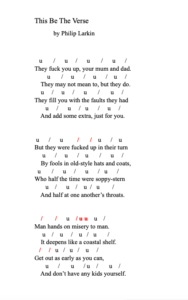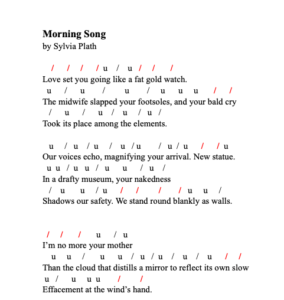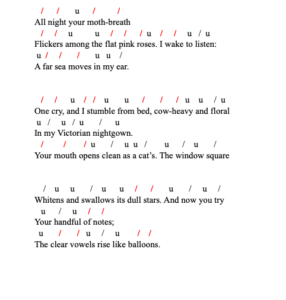In Part 1 of our series on meter, you learned what meter is and how to scan a poem. Now, find out how to use this tool to strengthen your own writing.
Scansion and Meter Part Two: How to Use Meter in Your Own Poems
Now that you know what meter and scansion are, let’s talk about ways to make these tools work for your own poems.
Regular meter can create a smooth, calm, or controlled sensory experience for your readers. Sudden change in meter can create surprise or tension in a poem, or it can call attention to and put pressure on a moment in your poem. Grouping stressed syllables (also called spondees) together can create emphasis and a staccato rhythm. This can slow a line of poetry down, but it also gives it texture and creates interest. In contrast, using mostly alternating stressed and unstressed syllables can create a flowing rhythm that speeds up a line.
Change the meter to call attention
Changing the meter suddenly in a poem can call attention to a line or phrase; sudden change in meter can also create tension, pressure, or heightened emotion. Let’s look at an example—try reading Philip Larkin’s This Be the Verse out loud. Notice how regular most of the meter is.

In this poem, because most of the meter is so regular, the moments in the poem where the meter is disrupted really stand out. There is a small disruption in meter in line 5, and another small disruption in meter in line 11, but the most noticeable change in meter is in line 9: “Man hands on misery to man.” This line begins with a spondee (two stressed syllables), which slows down the language in the poem considerably. The word “misery,” with its shift out of an unstressed/stressed pattern, also slows down this line. By slowing down the poem for this line, via the change in meter and the use of stressed syllables, Larkin effectively draws the reader’s attention to this line in the poem. While the poem is, for the most part, a lighthearted poem, this line takes on more gravity and weight, lending some pressure and tension to the poem as a whole.
Use Spondees to Slow Your Poem
Let’s look at another example. In Morning Song by Sylvia Plath, spondees, or groups of two stressed syllables together, are sprinkled throughout the poem to slow the poem and give it a punctuated, staccato rhythm. This prevents the poem from becoming sing-songy or too gentle, creating a contrast between the textured meter and the potentially too-sweet topic (a new baby):


In this poem, Plath does not necessarily use a strict, regular meter which can be broken for effect. Instead, she works between patterns of unstressed and stressed syllables, using the staccato spondees to create attention, sharpness, and a slower reading pace. Try listening to this poem, or read it out loud yourself. Notice how the spondees, highlighted in red, punctuate the poem.
Three More Strategies to Try
Try these three exercises to become more aware of how meter works in your own poems.
Read your poems out loud.
Read your poems aloud while looking in the mirror. Read them aloud to your pets, your roommates, your parents, your spouse. . . When you read your poems out loud, where does the meter trip, or change? Where does it flow smoothly? Mark the passages of your poem that seem to stop or stall because of the rhythm. Do those moments of change or flow help support the mood, meaning, or tenor of the poem?
Sing along to the radio.
Song lyrics are often very regularly metrical. If there is a song whose rhythm seems to fit with the mood or emotional landscape you are hoping to create in your poem, try writing your own “lyrics” (this is a poem!) using the same rhythm as the song. This will help you automatically or intuitively follow the song’s meter, and borrow its rhythmic mood.
Scan your own poem.
When you have a poem that’s not quite working, try scanning it (as we learned how to do in the previous blog). What do you notice about the poem’s meter? Is the meter supporting the parts of the poem that you want to emphasize? Is the meter supporting the poem’s overall tone or mood? Does the meter add to the pleasure or surprise in the language?
If you want to deep-dive into scansion and meter for some of your own poems, check out our 1:1 coaching offerings. Our Tell Tell editors would love to talk more about how your metrical choices can strengthen your poems!





Comments (0)